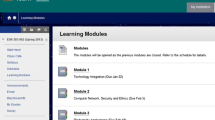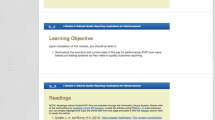Abstract
Given the rising popularity of content management systems (CMSs) in higher education, we investigated how students use the available CMS tools, as well as whether the moment of using a CMS tool affects students’ learning. This temporal dimension has been neglected in current research on CMS use. More insight into students’ tool-use is particularly important from an instructional design perspective because research has repeatedly revealed that a learning environments’ effectiveness depends heavily on students’ adaptive tool-use. Data were collected by logging the frequency and the time students (158) use the available tools within a CMS. Repeated-measures analyses revealed that students’ tool-use changed throughout the course, a dynamism that was different for each tool and was related to course-specific deadlines. Significant temporal student differences were found for some types of tools. Furthermore, students’ course performance was significantly impacted by the moment students used the course material outlines and the discussion board. In line with expectations, effects were different dependent on the tool. Hence, by examining students’ tool-use from a temporal perspective, this study highlighted that the timing of use matters. Furthermore, this timing depends on tool functionality. Consequently, the results have interesting implications for designing CMSs and they suggest implications for releasing some type of CMS tools at specific moments in the learning process.



Similar content being viewed by others
References
Acharya, C. (August, 2003). NUCast survey. Paper presented at the conference on human factors in computing systems, Montreal, Canada. Retrieved August 22, 2010 from https://team.nus.edu.sg/cdtl/staff/Research/CDTLMSNo_4.pdf.
Alexander, P. A. (2003). The development of expertise: The journey from acclimation to proficiency. Educational Research, 32(8), 10–14.
Alexander, P. A. (2004). A model of domain learning: Reinterpreting expertise as a multidimensional, multistage process. In D. Y. Dai & R. J. Sternberg (Eds.), Motivation, emotion and cognition (pp. 273–298). Mahwah, NJ: Erlbaum.
Alexander, P. A., Kulikowich, J. M., & Jetton, T. L. (1994). How subject-matter knowledge affects recall and interest. American Educational Research Journal, 31, 313–337.
Alexander, P. A., Kulikowich, J. M., & Jetton, T. L. (1995). Interrelationship of knowledge, interest, and recall: Assessing a model of domain learning. Journal of Educational Psychology, 87, 559–575.
Alexander, P. A., & Murphy, P. K. (1998). Profiling the differences in students’ knowledge, interest, and strategic processing. Journal of Educational Psychology, 90, 435–447.
Alexander, P. A., Murphy, P. K., Woods, B. S., Duhon, K. E., & Parker, D. (1997). College instruction and concomitant changes in students’ knowledge, interest, and strategy use: A study of domain learning. Contemporary Educational Psychology, 22, 125–146.
Alexander, P. A., Sperl, C. T., Buehl, M. M., Fives, H., & Chiu, S. (2004). Modeling domain learning: Profiles from the field of special education. Journal of Educational Psychology, 96, 545–557.
Anderson, J. R. (1987). Skill acquisition: Compilation of weak-method problem solutions. Psychological Review, 94, 192–210.
Anderson, J. R. (2000). Cognitive psychology and its implications (5th ed.). New York: Worth Publishers.
Anderson, L. W., & Krathwohl, D. R. (2001). A taxonomy for learning, teaching, and assessing: A revision of Bloom’s taxonomy of educational objectives. New York: Longman.
Bartholomé, T., Stahl, E., Pieschl, S., & Bromme, R. (2006). What matters in help-seeking? A study of help effectiveness and learner-related factors. Computers in Human Behavior, 22, 113–129.
Beal, C. R., Qu, L., & Lee, H. (2008). Mathematics motivation and achievement as predictors of high school students’ guessing and help-seeking with instructional software. Journal of Computer Assisted learning, 24, 507–514.
Bera, S., & Liu, M. (2006). Cognitive tools, individual differences, and group processing as mediating factors in a hypermedia environment. Computers in Human Behavior, 22, 295–319.
Brotherton, J., & Abowd, G. (2004). Lessons learned from eclass: Assessing automated capture and access in the classroom. ACM Transactions on Computer-Human Interaction, 11(2), 121–155.
Chan, A. Y., Chow, K., & Jia, W. (2003). A framework for evaluation of learning effectiveness in online courses. In R. W. Lau, Q. Li, R. Cheung, & W. Liu (Eds.), Advances in web-based learning—ICWL 2005 (pp. 383–395). Hong Kong: Springer.
Clarebout, G., & Elen, J. (2008). Tool use in open learning environments: In search of learner-related determinants. Learning Environments Research, 11, 163–178.
Clarebout, G., & Elen, J. (2009). Benefits of support devices in electronic learning environments. Computers in Human Behavior, 25, 804–810.
Coates, H., James, R., & Baldwin, G. (2005). A critical examination of the effects of learning management systems on university teaching and learning. Tertiary Education and Management, 11(1), 19–36.
Costen, W. M. (2009). The value of staying connect with technology: An analysis exploring the impact of using a course management system on student learning. Journal of Hospitality, Leisure, Sport & Tourism Education, 8(2), 47–59.
Dabbagh, N., & Bannan-Ritland, B. (2005). Online learning: Strategies, concepts and application. Upper Saddle River, NJ: Merrill.
Dabbagh, N., & Kitsantas, A. (2005). Using web-based pedagogical tools as scaffolds for self-regulated learning. Instructional Science, 33, 513–540.
Doyle, W. (1977). Paradigms for research on teacher effectiveness. Review of Research in Education, 5, 392–431.
Flavell, J. H. (1970). Developmental studies of mediated memory. In H. W. Reese & L. P. Lipsitt (Eds.), Advances in child development and behaviour (Vol. 5, pp. 181–211). New York: Academic.
Friend, L. C., & Cole, C. L. (1990). Learner control in computer-based instruction: A current literature review. Educational Technology, 30(11), 47–49.
Ge, X., & Hardé, P. L. (2010). Self-processes and learning environment as influences in the development of expertise in instructional design. Learning Environments Research, 13, 23–41.
Gerber, M., Grund, S., & Grote, S. (2007). Distributed collaboration activities in a blended learning scenario and the effects on learning performance. Journal of Computer Assisted learning, 24, 232–244.
Grabinger, R. S. (2008). Discussion. Computer in Human Behavior, 25, 836–840.
Hammoud, L., Love, S., Baldwin, L., & Chen, S. Y. (2008). Evaluating WebCT use in relation to students’ attitude and performance. International Journal of Information and Communication Technology Education, 4(2), 26–43.
Hannafin, M., Land, S., & Oliver, K. (1999). Open learning environments: Foundations, methods, and models. In C.M. Reigeluth (Ed.), Instructional design theories and models. A new paradigm of instructional theory (pp. 115–140). Mahwah, NJ: Lawrence Erlbaum.
Hoskins, S. L., & Van Hooff, J. C. (2005). Motivation and ability: Which students use online learning and what influence does it have on their achievement? British Journal of Educational Technology, 36, 177–192.
Huon, G., Spehar, B., Adam, P., & Rifkin, W. (2007). Resource use and academic performance among first year psychology students. Higher Education, 53, 1–27.
Iiyoshi, T., & Hannafin, M. J. (April, 1998). Cognitive tools for open-ended learning environments: Theoretical and implementation perspectives. In Paper presented at the annual meeting of the American Educational Research Association, San Diego.
Jiang, L., Elen, J., & Clarebout, G. (2009). The relationships between learner variables, tool-usage behaviour and performance. Computers in Human Behavior, 25, 501–509.
Jonassen, D. H. (1999). Designing constructivist learning environments. In C.M. Reigeluth (Ed.), Instructional design theories and models. A new paradigm of instructional theory (pp. 215–239). Mahwah, NJ: Lawrence Erlbaum.
Kalyuga, S., Ayres, P., Chandler, P., & Sweller, J. (2003). The expertise reversal effect. Educational Psychologist, 38(1), 23–31.
Knight, J. (2010). Distinguishing the learning approaches adopted by undergraduates in their use of online resources. Active Learning in Higher Education, 11(1), 67–76.
Lepper, M. R. (1985). Microcomputers in education: Motivational and social issues. American Psychologist, 40(1), 1–18.
Lowyck, J., Elen, J., & Clarebout, G. (2004). Instructional conceptions: Analysis from an instructional design perspective. International Journal of Educational Research, 41(6), 429–444.
Lumpe, A. T., & Butler, K. (2002). The information seeking strategies of high school science students. Research in Science Education, 32, 549–566.
Lust, G., Juarez Collazo, N. A., Elen, J., & Clarebout, G. (2012). Content management systems: Enriched learning opportunities for all? Computers in Human Behavior, 28, 795–808.
Macfayden, L. P., & Dawson, S. (2010). Mining LMS data to develop an “early warning” system for educators: A proof of concept. Computers & Education, 54, 588–599.
Murphy, P. K., & Alexander, P. A. (2002). What counts? The predictive power of subject-matter knowledge, strategic processing, and interest in domain-specific performance. Journal of Experimental Education, 70(3), 197–214.
Nutta, J. W. (2001). Course web sites: Are they worth the effort? NEA Higher Education Advocate, 18(3), 5–8.
Oliver, K., & Hannafin, M. J. (2000). Student management of web-based hypermedia resources during open-ended problem-solving. Journal of Educational Research, 94(2), 75–92.
Perkins, D. (1985). The fingertip effect: How information-processing technology shapes thinking. Educational Researcher, 14(7), 11–17.
Perry, N. E., & Winne, P. H. (2006). Learning from learning kits: Study traces of students’ self-regulated engagements with computerized content. Educational Psychology Review, 18, 211–228.
Schraw, G. (2006). Knowledge: Structures and processes. In P. A. Alexander & P. H. Winne (Eds.), Handbook of educational psychology (2nd ed., pp. 245–263). Mahwah, NJ: Lawrence Erlbaum Associates.
Shuell, T. J. (1990). Phases of meaningful learning. Review of Educational Research, 60, 531–547.
Traphagan, T., Kuscera, J. V., & Kishi, K. (2010). Impact of class lecture webcasting on attendance and learning. Educational Technology Research and Development, 58(1), 19–37.
Williams, M. D. (1996). Steps towards cognitive achievements. Elementary School Journal, 85, 673–693.
Winne, P. H. (2004). Students’ calibration of knowledge and learning processes: Implications for designing powerful software learning environments. International Journal of Educational Research, 41, 466–488.
Winne, P. H. (2006). How software technologies can improve research on learning and bolster school reform. Educational Psychologist, 41(1), 5–17.
Acknowledgments
This research has been made possible by a grant from the national science foundation- Flanders FWO-grant G.0408.09.
Author information
Authors and Affiliations
Corresponding author
Rights and permissions
About this article
Cite this article
Lust, G., Vandewaetere, M., Elen, J. et al. Tool-use in a content management system: a matter of timing?. Learning Environ Res 17, 319–337 (2014). https://doi.org/10.1007/s10984-014-9161-2
Received:
Accepted:
Published:
Issue Date:
DOI: https://doi.org/10.1007/s10984-014-9161-2




